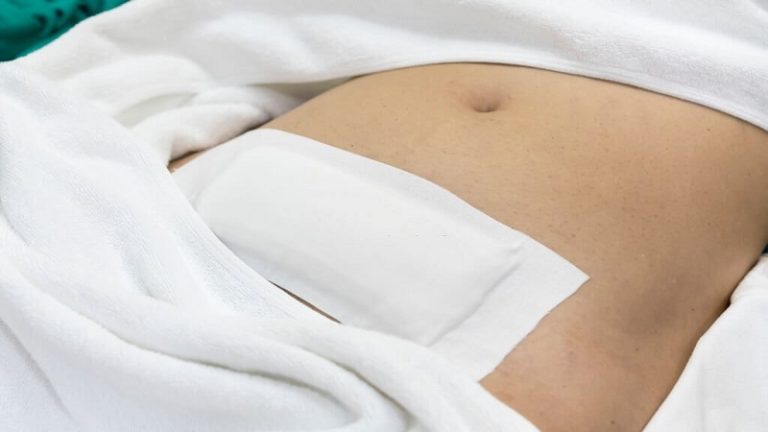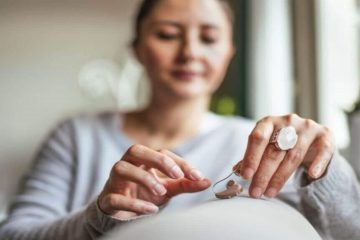Fibroids are muscular growths found in your uterus. Menopause is difficult because your body can’t find the hormonal balance it requires. Many women of all ages suffer from fibroids and many women end up with the fibroid problem during menopause due to the estrogen high.
Although fibroids are benign and often go unnoticed, they can grow large enough to extend over the stomach or into nearby organs. Therefore, you might begin encountering an abdomen bulge and gaining weight.
People who have a lot of fibroids with a previous surgery run a greater risk of weight gain after the surgery. The bigger the fibroids, the more weight people gain. However, not all fibroids cause weight gain.
Let your readers navigate with ease.
Take a full picture of your fibroid belly
“Fibroid belly bulge” or “scybal belly bulge” refers to cysts or embedded hysterectomies that can grow gradually and cause a rapid increase in the size of the belly, pushing it wider than normal or causing pain.
You’ll end up looking like you have a flat belly after your fibroids are removed, if only you start eating well and working out regularly. Just bear with me though because this isn’t an easy diet plan to follow!
I know whether my weight gain is due to fibroids

Because fibroids are a benign, most women with this condition are not even aware of them. You discover something wrong when you experience excessive bleeding every month, which is, in addition, unbearable and the period lasts for a week.
You may start to show a belly bump and put on weight. Fibroids may not be the only cause if it is fact that this is the only cause of your fat gain. You should get yourself diagnosed as soon as possible if –
Another symptoms are excessive bleeding with prolonged painful periods along with low back pain, leg pain and frequent urination. You maybe have an irregular menstrual cycle and bleeding between cycles. You probably have a belly bulge that you don’t notice but by when you are not pregnant.
Rapid Weight Gain Weight Loss
Losing weight can help trim fibroids, but with fibroids leading to heavy blood loss, losing weight is tough. That stimulates bleeding, and makes women so fatigued that they become lethargic and lose the desire to perform their daily chores.
There’s no extra energy that you can have when you want to exercise, nor can you continue to add business to your workload so you can spend a little time exercising. Adding to this is the fact that you try to overcome your weakness and lightheadedness by eating extra. Overtreating plus lack of exercise will only contribute to your fib
Fibroids Weight Chart
liver fibroid are the manifestations of liver damage where the liver is inflamed. The athlete’s after fibroids can be identified by ultrasound or MRI (magnetic resonance imaging) or endoscopy. Resolution of fibroid patients have shown normal liver damage by physical examination and imaging test.
However, understanding fibroids is easier is if you can compare them to something known. Consider a comparison of a 10 cm uterine fibroid to **** (omit by name of a fruit) – what’s that like? In addition, many fibroids have enormous weights. This estimation ensures you will be able to compare the size of your fibroid to something large, rather than something small!
Exams after fibroids removed
If fibroids weigh significantly more than the necessitated by the size of uterine cavity, it can cause an acute abdomen; actually, each ovarian cyst can push up the uterus and make it bulky. You can experience a sudden gain in weight and abdominal pain.
However, you’ll see a massive positive weight loss when your fibroids are removed so you’ll get back to your original weight after a large amount of fat waste.
Lifestyle changes after a fibroid removal
In order to lose weight following the removal of a fibroid tumour, you need to modify your lifestyle. Weight loss is dependent upon having a good night’s sleep, living in a stress-free environment, a healthy diet, and routine exercise.
Dietary Modifications
Vegetarian diets are an effective way to lose weight immediately after having fibroid-removal surgery. Simply put, bulk eats veggies and avoids all kinds of meat. Eat lots of fruits and leafy greens.
Leafy greens
These fruits taste great, contain vitamins, and have other health benefits too. Anemia, to which people commonly get when undergoing a fibroidectomy, can be treated by fibroid removal. During this process, many fruits play a role as a source of the vitamin A that the body needs
Iron is very important to women that suffer from fibroids. Without iron, women will be unable to cope with the strain of losing weight, when they have large fibroids. Their bodies will lack the amount of hemoglobin required to replace the blood lost during their periods.
Fiber-rich Foods
Eating a diet rich in whole grains, gluten-free oats, lentils, green leafy veggies, green beans, chia seeds (helps to make flax seeds easier to digest), and tomatoes may prevent most women from suffering from fibroids. Oats and chia also help with weight loss. Fiber is also key for
To keep the fibroid growth rate steady, a steady glucose level is essential to keep the insulin level constant; this constant level affects the level of estrogen in the body.
Vitamins A, B, and C
Most people affected by fibroids are vitamin D deficient, so it is important to overcome the deficiency and supplement it with natural sources (sunlight) or vitamin D supplements. The sunlight makes vitamin D in the skin and in fatty fish, so folks at higher latitudes get more exposure to sunlight and therefore have higher vitamin D levels. Egg yolks are foods that carry a moderate amount of vitamin D, and milk is another healthy source. It is important to get enough dairy in your diet if you want vitamin D and
Fruits
Apples, grapefruit, and pears are great for restoring a woman’s elasticity after the effects of the ovulation cycle. Apples and pears, particularly, have healthy estrogen blockers called phloretin, which are found in these fruits.
Eating colorful foods helps improve low iron levels caused by heavy periods, so ‘following the rainbow’ can probably help.
Herbs
If your fibroids are small, herbal treatment can be useful. It might not always be effective and requires a long time to show a significant improvement, but it may shrink fibroids in some cases.
Herbs such as dandelion, chamomile, goldenseal, barberry, milk thistle, and others work by detoxifying the liver, to cleanse the body of excess estrogen.
Hydrate plenty.
People are very often disconnected from their surroundings and are not aware that they are harming the environment. The amount of pollution a person is producing is smaller on per capita basis than the pollution of countries with fewer inhabitants, but the impact on the larger environment is enormous
Beet Root and Ginger
Because it’s not yet proven, peppers can help with mood and depression and are rich in vitamin C, B6 and antioxidant substances. Extend the paraphrase by summarizing the advice into an advice column.
Green Tea
Green tea may actually help prevent fibroid conditions by reducing estrogen levels in women’s pelvic areas, according to recent research. They are also high in antioxidants, which can help fight off inflammation in response to these conditions.
Keep a close look on foods that contain soy, processed food, red meat, dairy products, or alcohol. Try to avoid these foods listed below. Soybeans, soy milk, tofu, and foods purchased from supermarkets and food packaged in cans increase the estrogen levels in the body and may resulting inactive liver to remove excess estrogen. Insulin levels in the body increase as you eat more food, but remove you as much as you can. Caffeine disrupts brain to improve thinking. Chocolate increases the estrogen level in the body so resist as much as you can. Cannabis is a hempen- and barks-based drug that is used recreationally. Its negative effects are very limited.
Exercise Routine
Fibroids restrict the flow of blood to uterine muscle, so fibroid removal is a pre-emptive measure to make sure the uterus doesn’t continue growing. Fibroid bulging is often a factor in premature or multiple pregnancies. A daily exercise routine is also crucial before, after, and immediately after, minimally invasive fibroid surgery. Exercise makes the uterus stronger and helps quickly
After the abdominal surgery during which fibroid was removed, it’s necessary to take a long-lasting rest until the body is not used to exercise. Do not overdo exercising, therefore start with walking and swimming, and do yoga as well. To ensure that fibroid recurs, you shouldn’t stop the routine and revert to the smaller-calorie eating plan. Be positive and dedicated through the entire procedure.
How to get rid of fibroids

Removal of the uterus (hysterectomy) may be the only way to alleviate the pressure that a large fibroid in your uterus puts on nearby organs such as the bladder. However, infertility will result from the surgery so women interested in having a baby in the future will not want to have this procedure.
Your fallopian tubes along with ovaries are removed during the process if ovarian cysts are present. Even more important, the process has its own drawbacks that adversely affect your weight because of its 4-6 week recovery period.
For those who suffer from uterine fibroids, the treatment may start with myomectomy. For certain sizes and locations, laparoscopic or hysteroscopic myomectomy is a treatment option. As long as the fibroids are not inside the muscular layer of the uterine cavity(intramural fibroids) or within the inner surface of the womb(submucosal
If your fibroids are in the lining of your pelvic cavity, or “uterine cavity,” your doctor might suggest a trans-cervical hysteroscopic surgery, in which your doctor will cut/burn/inject your abnormal uterine tissue(s) (abnormal cells that are present in your body as “fibroids”))
Non-surgical uterine fluid embolization, UFE, is an increasingly popular procedure used to remove fibroids. This process focuses on shrinking fibroids by cutting off the blood supply to the tumors with catheters, thereby killing them. It has a fast recovery time, however, there are risks involved such as damaging the uterine blood vessels.
Meanwhile, there are other options include a procedure called endometrial ablation, which can interrupt your periods and remove the endometrial fluid that keeps your fibroids from spreading. This means treatment will be the only way to get fibroids removed if you don
Can you get flat abs after UFE?
Your fibroids have shrunk and the upcoming surgery will improve your quality of life so that you can get back to your normal lifestyle faster than other surgical procedures. With regular exercise and a healthy diet, you can have a flat stomach but it will take time to lose weight after fibroid removal.
Bottom Line
Fibroids are a common gynecological complication in women in their 40s, and menopause is triggering them. However, fibroids need to be removed carefully, and you should visit your doctor so you avoid unnecessary procedures.
After a fibroid is removed, it can be difficult to lose weight. Instead of focusing on your weight loss, focus on being positive.
FAQs
- Is UFE safe to do? Does it cause recurrence?
UFE has become commendable among women for preserving fertility and causing a fast recovery. It usually won’t cause of fibroids. Always consult your doctor for better views.
- Hysterectomy can cause weight loss?
Doctors believe that a hysterectomy leaves heavy metal traces in the bloodstream even when done with anesthesia, so a patient must regain the weight she lost before she can gain the benefits of a post-op juicing and eating regimen. Women who undergo a hy
- Can I tell if I’ll need surgery to remove my fibroids?
If you have serious periods, heavy bleeding, and are bloated and pain in your belly, you might have fibroids. You should speak to your doctor about these types of issues regarding fibroids. More importantly, you can have a non-surgical procedure to remove them.
- What is the weight of a 5 cm fibroid?
A “medium” tummy bulge is about the size of a plum, while a tummy bulge that stretches 10 cm or more is comparable to the size of an orange or a watermelon.
- Can fibroids cause weight loss?
Fibroids are rarely associated with weight loss, but they can become very large. As such, it’s important to evaluate your permits if you find that you’re gaining weight. Fibroids can be treated effectively. So, make sure you consult a doctor.
- What happens when I have fibroids removed?
You are likely to lose weight after fibroid removal when the condition is eradicated, you can get back to your usual routine, and your thyroid starts receiving the usual signals again.
- After fibroids are removed?
You’ll immediately be able to see a difference in the size of your belly when you’ve had your fibroids removed. The symptoms associated with fibroids that you had been experiencing — including excessive bleeding, extremely painful menses, frequent urination, lower back and leg
- How long does total hysterectomy take?
The procedure takes about an hour to four hours. The duration will vary based on how complicated your surgery is.
- What makes fast growing fibroids expand?
Fibroids are a sign of increased estrogen, a hormone in women, so increasing estrogen could be the cause of fibroids. Other factors such as diet, overeating and lack of exercise, and other environmental factors are also implicated in fibroids. Doreen Bird, Vancouver Sun
- It can take 3 months for a fibroid to grow?
Often fibroids simply grow from 7% to 3 months and generally increase more or less in that time period. They can grow up to 36% according to statistics.




